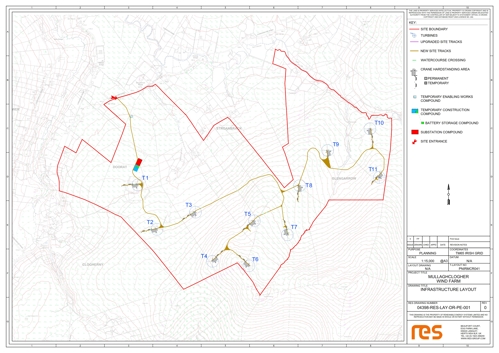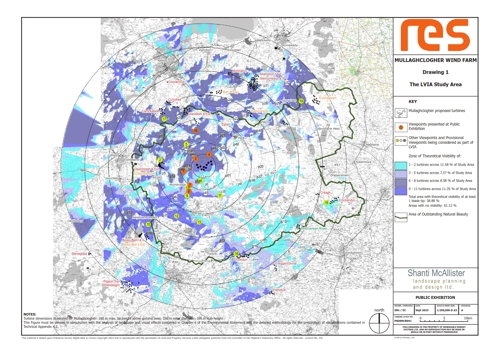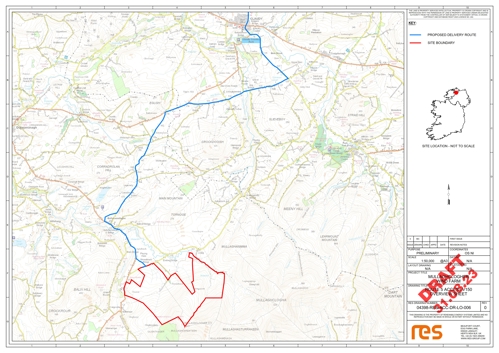Public Exhibitions
As part of our pre-application consultation we held public exhibitions in the local area in September 2023, to share more information about the project and to enable people to provide us with their feedback. The online public exhibition was designed for anyone who was unable to visit the public exhibitions. On this page you will find all the information about the proposal which was presented at the exhibitions.The exhibitions initiated a consultation period being run by RES to gather comments on the proposal. The closing date for comments was Friday 22nd September 2023 at 5pm. Comments will still be accepted but may not be considered in relation to the design development. Please contact us for more information.
The feedback will be taken into consideration, along with the results of site surveys and assessments, as we refine the design.
About the Project
RES is currently consulting on its plans for a proposed wind farm called Mullaghclogher located in the townlands of Carrickayne, Legnahappoge, Glengarrow, Stroanback and Doorat. The site is located approximately 4km northeast of Plumbridge.
Mullaghclogher Wind Farm has been designed to generate reliable, renewable electricity, whilst minimising local impacts and maximising local benefits wherever possible.
The wind farm would be capable of generating around 72 megawatts (MW) of clean, green, low-cost renewable electricity. Equivalent to the electricity usage of around 86,0001 homes each year.
Design Layout and Infrastructure
The wind farm proposal is for up to 12 turbines up to 180m in height.
The preliminary layout has been developed in response to the results of initial environmental surveys that have been undertaken at the site so far. The surveys help us to build up a picture of sensitive features (constraints) on and around the site, which we then take account of in the design of the layout.
In addition to high-level necessities such as good wind-speeds, we have considered a number of site-specific features and buffers. These include turbines being located a minimum of 1km from nearest properties, 50m from major watercourses and 10m from minor watercourses as well as avoiding areas of ecological interest and prominent hilltops.
Click on the image below to see a copy of the Key Constraints plan.
RES is currently consulting on this layout and as such it is subject to change.
Environmental Studies
As part of the planning process, RES undertakes an Environmental Impact Assessment (EIA). The purpose of the EIA is to investigate and alleviate any potential effects of a development on the natural, physical and human environment. An EIA includes the following assessments:
- Ecology
- Ornithology
- Fisheries
- Hydrology
- Geotechnical
- Landscape and visual
- Archaeology and cultural heritage
- Socioeconomic
The results of these surveys will be included in the Environmental Statement which will form part of any planning application that is submitted.

Photo: Badger / Shutterstock image (for illustrative purposes only)
What Would the Wind Farm Look Like?
We have produced indicative visualisations to help give an impression of what the wind farm could look like from different viewpoints in the area. Click on the links below to view.
VIEWPOINT 1 - Balix Upper to west of site
VIEWPOINT 3 - Stroanbrack Road near B48 and Aghanbrack GAA
VIEWPOINT 4 - Craig to north of site
VIEWPOINT 7 - Fairview Road, Plumbridge
VIEWPOINT 8 - Slievebeg Road near B48 to south of Plumbridge
Traffic and Access
Access is one of the key considerations when selecting a potential wind farm site, particularly with regard to the turbine deliveries.
The preferred access point and turbine delivery route are shown on the map to the right.
A transport assessment will be undertaken as part of the Environmental Impact Assessment (EIA) process and, if the wind farm is given consent, a detailed Traffic Management Plan will be agreed with Department for Infrastructure (DfI) Roads, the emergency services, the local community, and other relevant bodies.
Wherever reasonably practicable we will use materials available on site and source construction materials locally in order to help reduce traffic movements.
Noise
Wind farm noise in many circumstances may be inaudible or effectively "masked" by the background noise already present in the surrounding environment. We take care to ensure noise levels from wind turbines are within recommended limits and comply with planning policy. For Mullaghclogher Wind Farm we are undertaking a noise impact assessment in accordance with relevant guidance and in consultation with the local council's Environmental Health Department.
The results from these surveys enables us to gain an understanding of the existing noise environment and feed into the design of the wind farm. As a result of the existing background noise levels and the distances from surrounding properties, the proposed wind farm will comply with the relevant guidance on wind farm noise.
Click on the image below to see the noise footprint plan for Mullaghclogher, based on the current layout. This plan also shows the survey locations used for the noise impact assessment.

Supply Chain Opportunities
RES has a strong track-record of working closely with the local supply chain around its projects and maximising inward investment opportunities wherever possible.
Mullaghclogher Wind Farm has the potential to deliver approximately £3.3 million to the local area in the form of jobs, employment, and the use of local services.
RES is keen to hear from local businesses who are interested in learning more about the opportunities associated with the construction and operation of this project.
During the construction of Castlecraig Wind Farm, near Drumquin, over £3 million inward investment was realised into the local economy. The wind farm construction also provided employment for around 50 local people.
The construction of Altaveeden Wind Farm, near Loughguile was an economic success for local area, with £1.3 million invested directly into Co. Antrim with £772,000 of this spent within 5 miles of the site. A number of local contractors were used including P. Keenan and Sons, F.P. McCann and William and Henry Alexander (Civil Engineering) Limited.
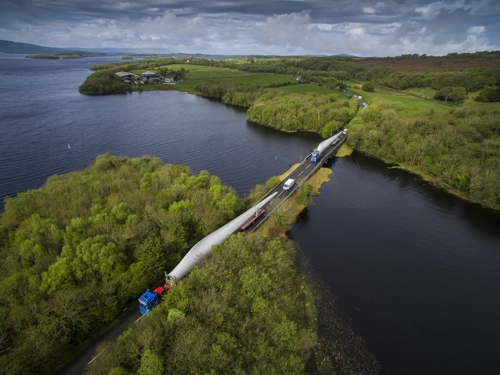
Turbine deliveries at Castlecraig Wind Farm, near Drumquin, where £3 million inward investment was realised into the local economy.
Why Wind?
Wind is a free and inexhaustible resource which has an important role to play as part of a balanced energy mix.
Tackling Climate Change by supporting Northern Ireland’s Climate Bill, which has a target of 80% of electricity consumption from renewable sources by 2030.
Can be quick to deploy. Onshore wind, alongside large scale solar and offshore wind are now the cheapest forms of new electricity generation1.
Enables us to generate our own electricity reducing reliance on imports and improving security of supply.
Northern Ireland consumers avoided paying £500 million to import gas last year because wind farms provided nearly 42% of our electricity3.
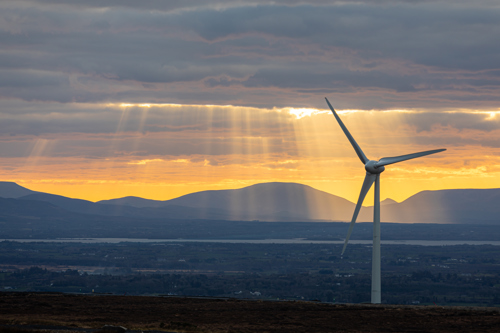
Bunnyconnellen Wind Farm, Co. Mayo. For illustrative purposes only.
RES in Northern Ireland
RES has been playing a pivotal role in providing Northern Ireland with renewable energy since the early 1990s.
Working together with businesses based in Northern Ireland our projects contribute to the local economy and utilise our home-grown energy sources.
With the urgent need to escalate decarbonisation, RES remains committed to being part of Northern Ireland's energy future and business growth, through maximising contributions from renewable energy.

Brackagh Wind Farm, Draperstown. For illustrative purposes only.
2 https://assets.publishing.service.gov.uk/media/6556027d046ed400148b99fe/electricity-generation-costs-2023.pdf
3 https://renewableni.com/wind-saves-ni-500m-in-2022



